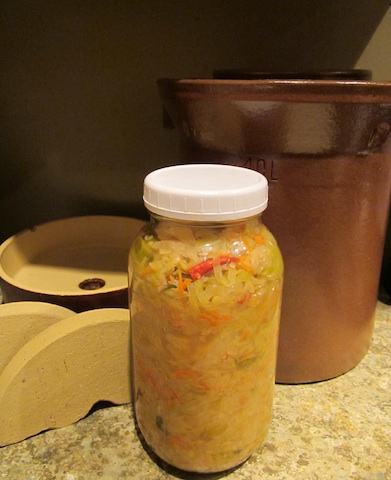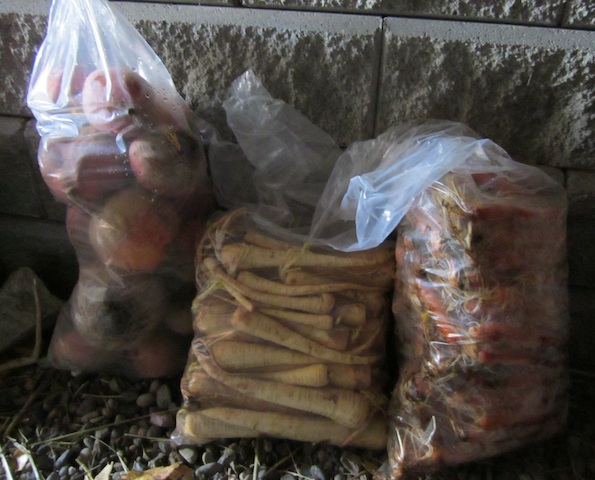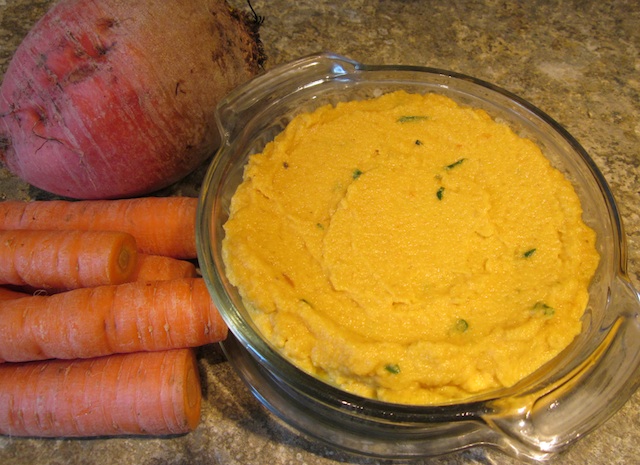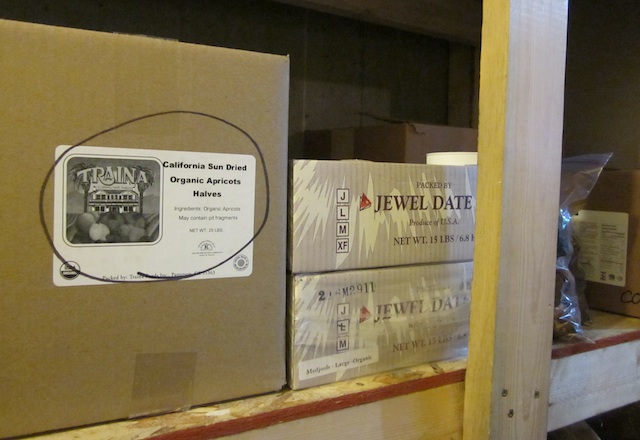
This is part of our dried storage area. We like to have a large section of organic dried fruits, mushrooms, spices and other organic bulk items. We buy in bulk to save on costs.

We like having a large section of organic beans, legumes, and whole grains. We grind our own flour at home.
Our household has three types of winter storage. We use a root cellar, dry storage and freezers. The root cellar is humid and cool, which is good for storing: potatoes, carrots, parsnips, rutabagas, cabbages, onions, garlic, shallots, green tomatoes, raw cheese and crocks of fermented vegetables. The dry storage is dry and cool, which is good for storing: dried fruits, ground coconut, grains, beans, legumes, assorted herbs and raw honey. We have over 70 cubic feet of freezer space in which we store: beef, pork, lamb, chicken, turkey, organ meats, bones, raw milk, raw butter, butter, nuts, seeds, berries, tomatoes and assorted vegetables.

This freezer used to be full of raw milk. We will run out of milk before Olivia gives birth to her next calf. Normally, I would never store anything with frozen milk to avoid off flavors getting into the milk but I ran out of space in my other freezers.
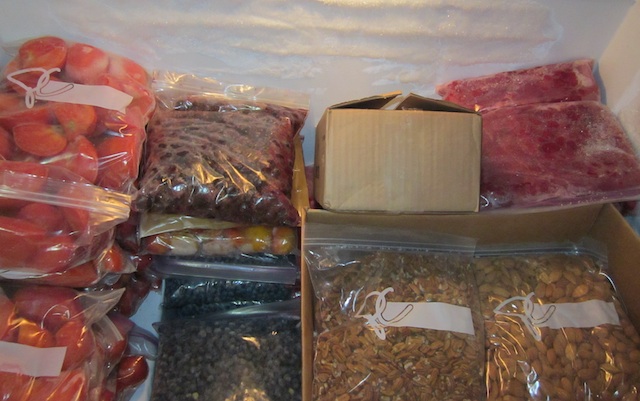
This is my fruit freezer. It was full at the beginning of winter. I now have space for nuts. When nuts are shelled it is better to store them in the freezer to protect their delicate oils.

This freezer would normally be empty by this time of year. One of our big freezer's compressor failed. We where lucky that we didn't lose any food. It is a good idea to have a temperature alarm on all freezers to avoid this kind of problem.
Three years ago, we came to Kamloops and moved into an old mining pit. The soil is clay, rock and gravel. The first year we were busy building the warehouse and a home. The second season we started the garden. We had to bring in compost, peat, and manure from all over the city to grow anything. We planted fruit trees, currents, raspberries and other food producing plants. We use drip irrigation and a small number of spray emitters. The soil was so hard and rocky I was using a rock pick to dig shallow holes to plant my herb garden. Many plants died that first year.
The quickest way to build soil is animals. We have run chickens for two seasons now. Shaen is the gardener in the family and he has had some production this year. We have had good production from: raspberries, strawberries, some tree fruits, spaghetti squash, beets, zucchini, chard, tomatoes, green beans, herbs and dried beans. Everything else languished or died.
The last week, has been a race with the weather to remove the remainder of our crops from the garden. We managed to put away some spaghetti squash, pie pumpkins and green tomatoes in the root cellar. We froze some raspberries and green beans. We put away a very small amount of dried beans into our dry storage. It was chickens that really worked this year. We put away 120 chicken or about 600 pounds of meat in our freezers. We have eleven turkeys still growing in the back “pasture”. Our new laying hens are consistently producing over a dozen eggs a day.
Every urban homestead starts from humble intentions. The urban homesteader must be flexible. The land can only produce what the land can produce. The urban homesteader must be patient. With careful tending and a little effort, the land will produce more and more each year. If we are in a hurry, production can be increased, but a cost will be paid in labor or money. The urban homesteader needs to be grateful. Whatever comes is a bounty, a gift, from the land. In our modern world we have forgotten how precious food is. Growing your own food counteracts this delusion.
These are some of the local producers I have used for dry stores and for our freezers:
1. Westsyde Apiaries: 250.579.8518: raw honey, raw honey comb
2. Fieldstone Granary Ltd: 250.546.4558: organic spelt kernels, golden flax seed, oat groats, green lentils, and buckwheat groats, chicken scratch
3. Healthylife Nutrition: 250.828.6680: raw pecans, raw walnuts, shredded coconut, raisins, currents, dates (Once a year fall order from www.ranchovignola.com.)
4. Jocko Creek Ranch: 250.374.9495: grass fed beef, grass fed lamb
5. Lyne Farm: 250.578.8266: grass fed beef, grass fed veal
6. Beaver Valley Livestock Services: 250.243.2257: pastured pork
7. Big Bear Ranch: 250.620.3353: pastured organic pork
8. Golden Ears Farm: 250.679.8421: unsprayed strawberries
9. Highland Farm: 250.803.0048: organic cherries
10. Blueberry Hill Farm: 250.246.4099: unsprayed blueberries
11. Avalon Dairies: 604.456.0550: pasteurized organic butter (Good for cooking.)

